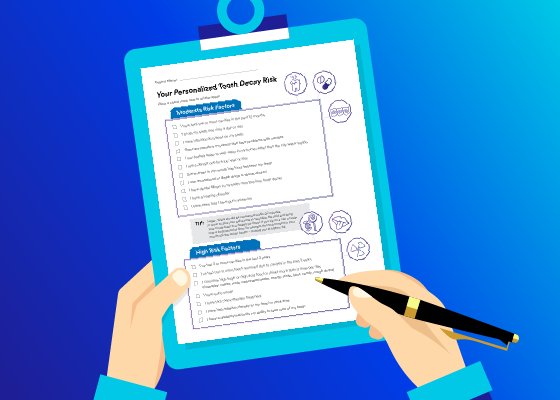Caries classification and assessment systems
Implementing a caries classification and assessment system in your office has more benefits than simply helping categorize lesion progression. These systems are evidence-based, preventive care models that help identify individual patient medical, behavioral, environmental, and societal risk factors that may cause decay, as well as classify and monitor existing or potential lesions along a structured scale. From there, this information can be used to recommend preventive and restorative treatment to reduce the risk of future decay.
Plus, caries risk assessments are inherently designed to help preserve tooth structure, which aligns with minimally invasive strategies. They encourage treating the disease process rather than the outcome. And while the assessments are standardized, they actually help individualize preventive treatment planning.
Open up! Assessments and patient communication
Beyond classifying existing risks, caries risk assessments can be helpful in determining oral health literacy – to see what patients already know and where you may need to educate them further.
Depending on how the clinician presents and implements the assessment, it can be very personal, which can help the patient identify goals they want to work on – and help the clinician identify any barriers that are getting in the way of the patient achieving their best oral health. These assessments can help identify things we can’t otherwise sift out in the medical history or hygiene instructions. It can also be a way for patients to open up and give you a lot of valuable information that you can then use in a standardized way to tailor your treatment and home care recommendations.
Dental professionals know that moderate to high-risk patients can benefit from regular applications of in-office fluoride or at-home prescription toothpaste, but not all risks are obvious. CAMBRA covers saliva and hyposalivary medications, diet, OTC fluoride use, and existing disease indicators to help guide treatment recommendations. For example, a patient with reduced salivary flow has an increased risk of caries. If they are also low on their essential salivary buffers like calcium and phosphate, you may want to recommend a product that has those minerals in addition to fluoride. Some offices offer bacterial testing, out of which you might recommend antimicrobial therapy. CAMBRA can also help us identify and treat patients with medical conditions (chemo or radiation, Sjögren’s syndrome, etc.) who would benefit from more frequent fluoride applications. CAMBRA reminds us to take a holistic approach to caries prevention and management — looking at the whole person and their unique circumstances. Through these assessments, you can recommend over-the-counter products for lower-risk patients or identify whether prescription products are better suited.
Risk assessments in practice
Thankfully, a team interested in implementing one of these protocols wouldn’t have to start from scratch – there are existing tools rooted in scientific literature that have already proven effective with patients.
Existing assessments with accompanying recommendations – to be used with our own clinical judgment on a case-by-case basis – can be used as a guide for treatment recommendations for all patients. For example, Caries Management by Risk Assessment (CAMBRA), developed by the California Dental Association over 20 years ago, is still widely used, straightforward, and easy to implement. Questions are worded in a way that you can work them into a conversation rather than reading from a checklist. Keep in mind that many of these systems are categorized by age, so depending on who you service, you may need more than one to cover all your clientele. In addition, these assessments are designed to be regularly updated with patients – so that we are routinely checking their risk at set time intervals for progress or changes – as well as refreshed with new scientific evidence, so you and your practice can stay up to date.
Assessments like CAMBRA can be implemented as is or used as a template/guideline to develop your own system – whatever works best for you and your practice. You don’t have to abandon what you already use; bringing CAMBRA or something like it into your day could help keep you at the top of your game: making sure each patient gets the treatment they need.



